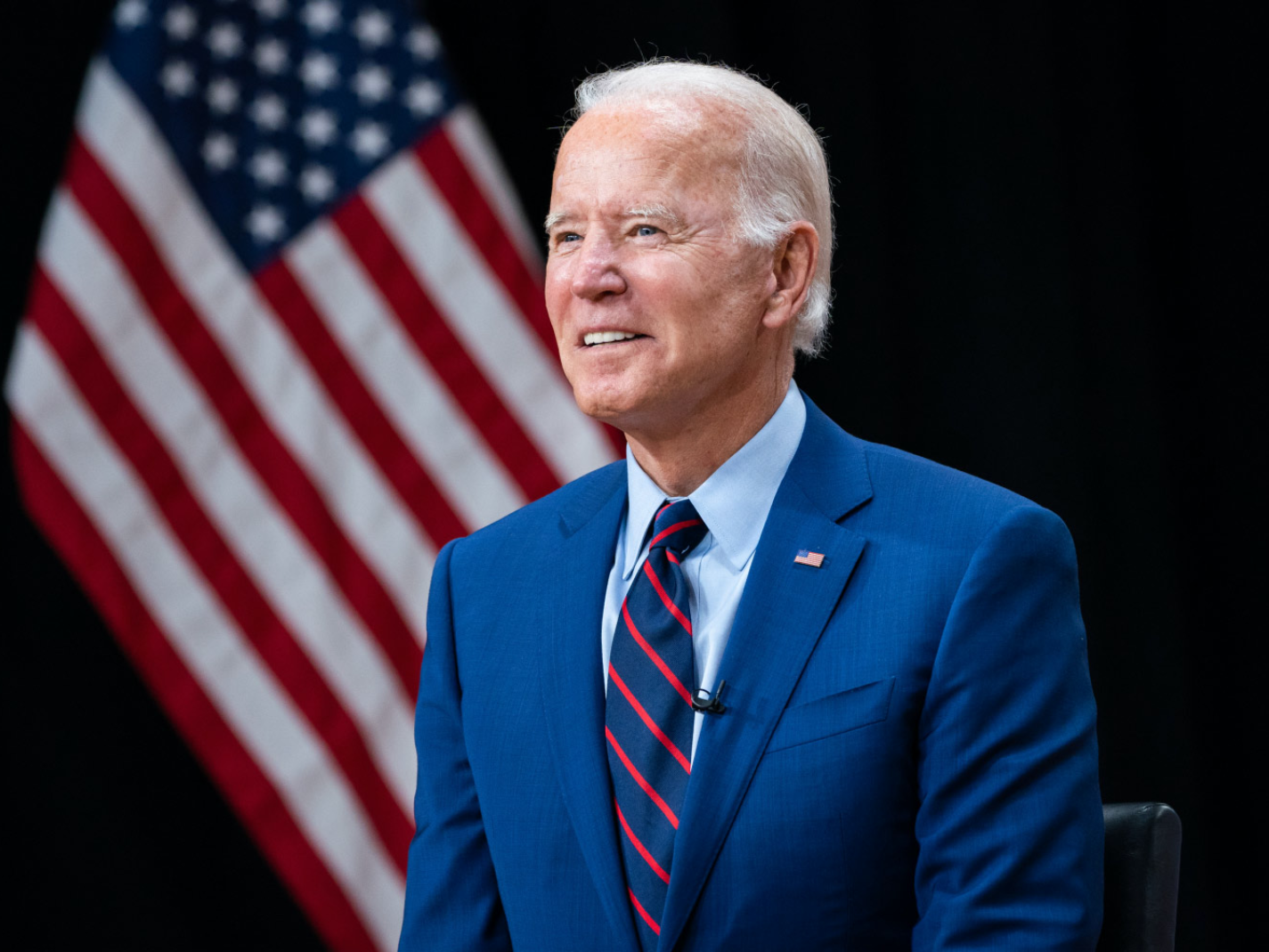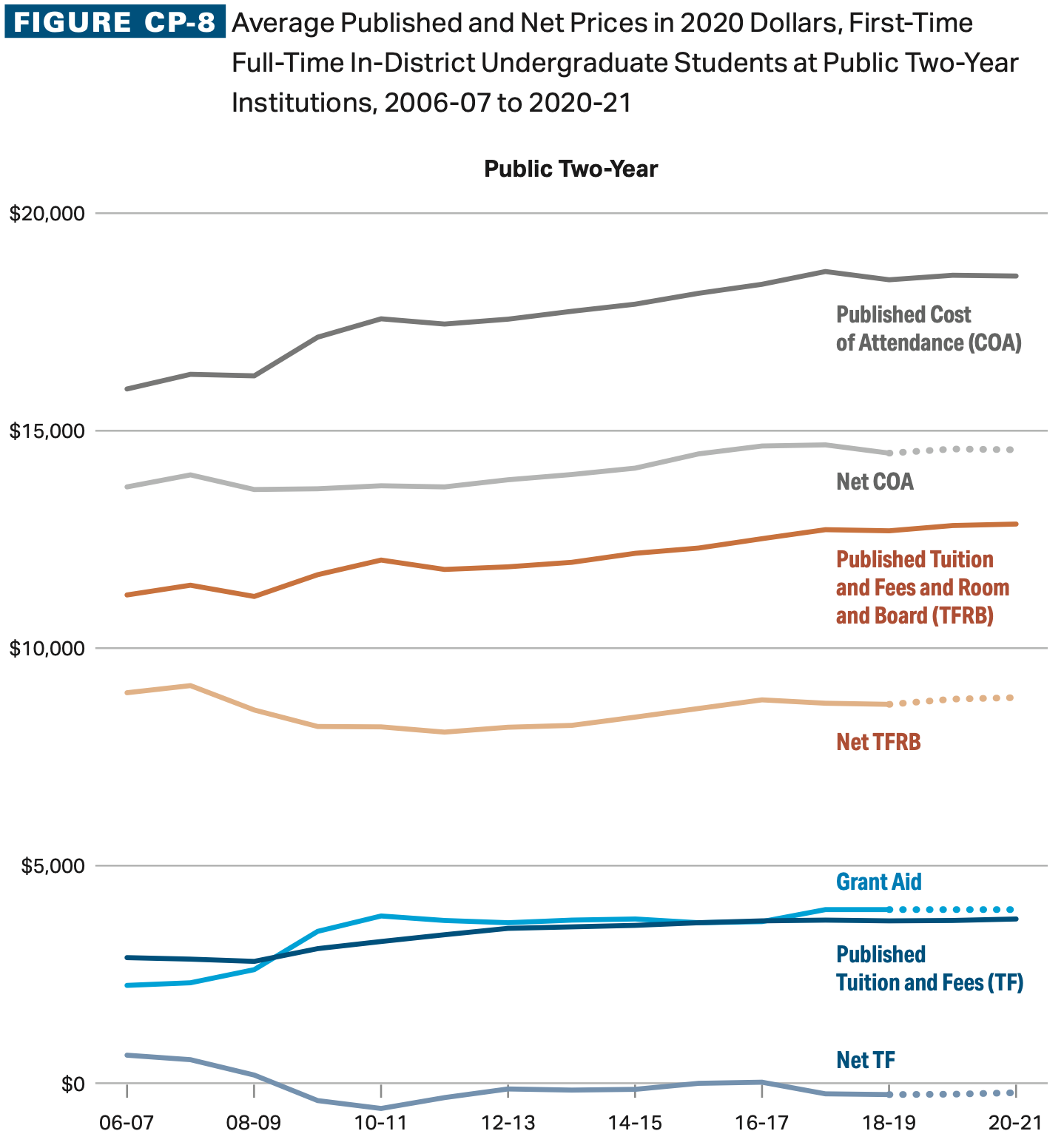
Details are starting to emerge about the Biden administration’s plans for free community college. According to a story in Inside Higher Ed by Alexis Gravely, the key details include:
- States that opt-in must set community college tuition and fees to $0 and must maintain current spending on community colleges.
- To offset the loss of tuition, the federal government provides a per-student grant equal to the median in-state tuition and fee charge among states (more on this shortly).
- In 2023-24, the federal government would cover 100% of the grant, falling by 5% per year until 2027-28 when it reaches 0%. States would be responsible for covering 0% in 2023-24, rising to 20% in 2027-28, and then 100% from 2028-29 on (if they choose to continue the program).
What should we make of this plan?
1. The Biden plan is a solution in search of a problem—on average, we already have free community college.
“Free community college” typically refers to $0 in tuition and fees. Fortunately, the College Board has a very useful annual report that tracks aid and pricing, allowing us to see how expensive various types of colleges are. Free community college would entail a value of $0 for net tuition and fees (the sticker price of tuition and fees minus grant aid). As a figure reproduced from the College Board report shows, we’ve had de facto free community college in this country since 2009-10 (the bottom line shows net tuition and fees).

Source: Trends in College Pricing and Student Aid 2020, The College Board
The College Board reports an average value, so some students are paying to attend community college. Nevertheless, on average, the net tuition and fees for public community college in America are slightly negative, meaning that on average, students are paid to go to community college.
There is just not that much for a new federal free community college program to do when we already essentially have free community college. Moreover, the organization No Labels documents that 20 states already provide some sort of free community college program.
2. There’s a better way to increase community college affordability: Pell grants.
The workhorse aid program that has already provided de facto free community college is the Pell grant program. The average cost of community college is $3,377, and the maximum Pell grant is $6,495. Thus, a student receiving the maximum Pell grant can cover all of his tuition and fees and still have some money left over for books, food, and living expenses.
Increasing the Pell grant would allow more students to access free community college. But the Biden plan instead relies on starting numerous federal-state partnerships as well as new methods of disbursing and tracking funds, which will likely face stiff political opposition.
Wouldn’t it be better to rely on Pell grants, which have already produced de facto free community college, have strong bipartisan support, and have a proven track record?
3. The Biden plan does not provide free community college.
Despite its claims to the contrary, the grant does not actually provide free community college. The grant will cover tuition and fees in some states that don’t charge much, but will not cover tuition or fees in other states that charge more. Jason Delisle and Jason Cohn find that under one plausible estimate, the plan would only result in free community college in 29 states. In other words, even if enacted, there would still be calls for a nationwide free community college program, because this one doesn’t accomplish its stated purpose.
4. The Biden plan would not fuel tuition increases (the Bennett Hypothesis is not a concern).
While I’m pretty skeptical of the Biden plan in general, one of the things it gets right is its double protection against the Bennett Hypothesis. One of the biggest problems with federal financial aid programs is the incentive it gives colleges to strategically raise prices (a phenomenon known as the Bennett Hypothesis). This problem has plagued most federal aid programs, but in a development that I hope carries over to all future financial aid programs (and reforms existing ones), the Biden plan includes two mechanisms that short-circuit this tendency.
The first mechanism is price controls. Requiring participating states to set community college tuition and fees to $0 will ensure that the grant does not simply result in colleges raising tuition. While I’m opposed to price controls in general, when a government is providing massive subsidies to producers, it is absolutely kosher for a government to place restrictions on the prices those institutions can charge. In fact, most states already do this, restricting how much state universities can charge as a condition of receiving state appropriations. The federal government has historically avoided the need to do so by providing funding to students instead of colleges or states, but if it starts funding colleges or states, it should arguably mimic the state restrictions on pricing.
5. The median cost mechanism is on the right track but is botched.
The second mechanism that, if properly applied, would limit potential tuition increases in response to the new aid is the median cost feature, in which the amount of the grant is determined by the median cost among states.
The Bennett Hypothesis arises because aid eligibility is currently determined for each college separately. If a college raises tuition by $1, students automatically become eligible for $1 more in federal financial aid. This allows colleges to raise tuition without substantially reducing the number of students who can afford to attend. As I’ve argued before, using the median cost of college among colleges (rather than the cost at each specific college) would short-circuit the Bennett Hypothesis. This way, if a college raises tuition, its students no longer automatically qualify for more aid.
However, the median should be calculated based on student enrollment. Instead, the Biden plan would calculate this median among states. As New America’s Kevin Carey documents, this was done because California has a ton of community college students (around 2 million) and doesn’t charge much, so the student enrollment-weighted median would provide a much smaller grant. This would further show Point 3, above, that this plan doesn’t actually provide free community college.
6. The plan might lower funding for community colleges in some states.
One would expect that a program intended to bolster community colleges would make sure the new funding is devoted to community colleges. Yet the Biden plan fails to do this.
The plan includes a maintenance of effort provision, meaning that states would need to spend at least as much money on community colleges going forward as they did in the past. But the plan also eliminates a revenue source for community colleges (by requiring $0 tuition and fees), and then gives the money that is intended to offset this loss of revenue not to the colleges, but to the states. Given that community colleges are widely viewed as being under-resourced from these same state governments, why should we expect that this new money will flow entirely to community colleges? It is even possible that some states would participate in the program, but then divert the grant money elsewhere, leaving community colleges with even less financing than today (since they would lose all tuition revenue).
Overall, the Biden plan seems like a bad idea. The problem it seeks to solve is largely non-existent. To the extent there is a problem, there are better solutions for addressing it, and it might end up harming community colleges in the long run.
Image: The White House, Wikimedia Commons, Creative Commons Attribution 3.0 United States license.
So after four years states have to pay 100% of the cost of the program? So what makes this a federal program — other than a federal program that only lasts for four years and then ends? Doesn’t that make the entire thing pointless? I’m confused. I don’t see the author addressing this; am I missing something?
The author is beating around the bush. There are two main ugly aspects of biden’s “free community college” plan. First, there is no free lunch; somebody always pays. Taxpayers will be forking over the money the government will use to cover the costs. Second, he who pays the piper, calls the tune. You own say a small construction business. You decide to go to the local community college to take a bookkeeping or a business class to help make your business more efficient. But alas, you find out the government has determined the economy already has enough bookkeepers so they’re not offering any classes on that now or for the foreseeable future. But, hey, there are still openings in the electric vehicle repair class.
A good analysis. The free CC plan makes no sense to me. It just looks like more federal encroachment. And that is even before I get to the effects on the four year public and private colleges.